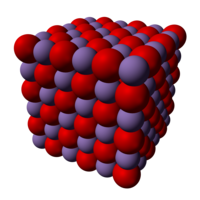Manganous oxide
 |
|
| Names | |
|---|---|
|
IUPAC name
Manganese(II) oxide
|
|
| Other names | |
| Identifiers | |
|
1344-43-0 |
|
| ECHA InfoCard | 100.014.269 |
| PubChem | 14940 |
| RTECS number | OP0900000 |
| Properties | |
| MnO | |
| Molar mass | 70.9374 g/mol |
| Appearance | green crystals or powder |
| Density | 5.43 g/cm3 |
| Melting point | 1,945 °C (3,533 °F; 2,218 K) |
| insoluble | |
| Solubility | soluble in acid |
| +4850.0·10−6 cm3/mol | |
|
Refractive index (nD)
|
2.16 |
| Structure | |
| Halite (cubic), cF8 | |
| Fm3m, No. 225 | |
| Octahedral (Mn2+); octahedral (O2−) | |
| Thermochemistry | |
|
Std molar
entropy (S |
60 J·mol−1·K−1 |
|
Std enthalpy of
formation (ΔfH |
−385 kJ·mol−1 |
| Hazards | |
| Flash point | Non-flammable |
| Related compounds | |
|
Other anions
|
Manganese difluoride Manganese(II) sulfide |
|
Other cations
|
Iron(II) oxide |
|
Manganese(II,III) oxide Manganese(III) oxide Manganese dioxide Manganese heptoxide |
|
|
Except where otherwise noted, data are given for materials in their standard state (at 25 °C [77 °F], 100 kPa).
|
|
|
|
|
| Infobox references | |
Manganese(II) oxide (systematically named manganese(2+) oxide(2−)) is an inorganic compound with chemical formula MnO. It forms green crystals. The compound is produced on a large scale as a component of fertilizers and food additives.
Like many monoxides, MnO adopts the rock salt structure, where cations and anions are both octahedrally coordinated. Also like many oxides, manganese(II) oxide is often nonstoichiometric: its composition can vary from MnO to MnO1.045.
Below 118 K MnO is antiferromagnetic. MnO has the distinction of being one of the first compounds to have its magnetic structure determined by neutron diffraction, the report appearing in 1951. This study showed that the Mn2+ ions form a face centered cubic magnetic sub-lattice where there are ferromagnetically coupled sheets that are anti-parallel with adjacent sheets.
Manganese(II) oxide undergoes the chemical reactions typical of an ionic oxide. Upon treatment with acids, it converts to the corresponding manganese(II) salt and water. Oxidation of manganese(II) oxide gives manganese(III) oxide.
MnO occurs in nature as the rare mineral manganosite.
Commercially it is prepared by reduction of MnO2 with hydrogen, carbon monoxide or methane, e.g.:
MnO can also be prepared by decarbonation of the carbonate:
This calcining process is conducted anaerobically to prevent formation of Mn2O3.
An alternative route, mostly for demonstration purposes, is the oxalate method, also applicable to the synthesis of ferrous oxide and stannous oxide. Upon heating in an oxygen-free atmosphere (usually CO2), manganese(II) oxalate decomposes into MnO:
...
Wikipedia
